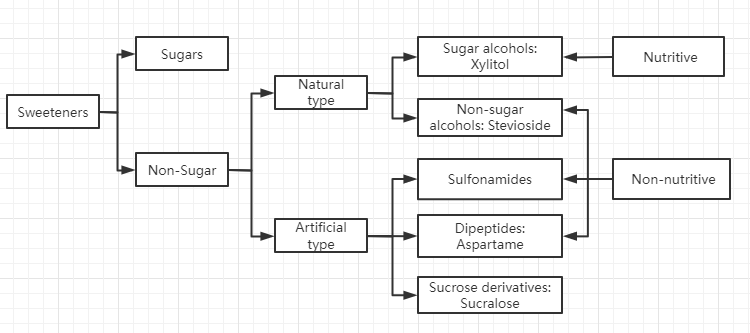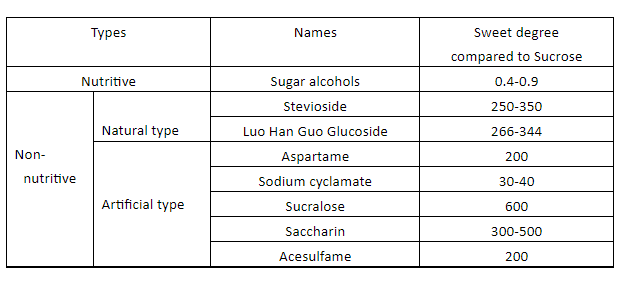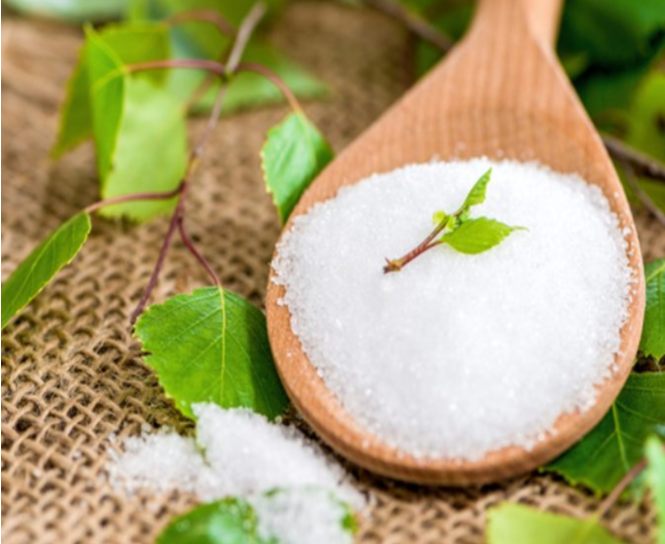Apr. 06, 2022
Concept and classification of sweeteners Sugars, i.e. carbohydrates, are mainly divided into monosaccharides, disaccharides, oligosaccharides and polysaccharides. The added sugars usually referred to are generally monosaccharides and disaccharides, commonly known as glucose, fructose, sucrose, maltose, lactose, etc. Their capacity factor (i.e. energy produced by 1g) is basically about 4kcal/g. The most commonly applied added sugar in the food industry is sucrose.
Sweeteners (sugar substitutes), a class of substances that provide less than 2% of energy at the same sweetness as the reference sugar (sucrose), belong to food additives, and the more common ones are xylitol, aspartame, acesulfame, etc. According to the source, sweeteners are divided into natural and artificial types; according to whether they can produce heat, they can be divided into nutritional and non-nutritional types. Compared with the same quality of sucrose, the sweetness of sweeteners varies from 0.4 to 1000 times that of sucrose. Nutritive sweeteners are generally less sweet than sucrose and produce energy during metabolism, so they are rarely added as separate sweeteners in sugar substitute foods. The sweetness of non-nutritive sweeteners is significantly higher than that of nutritive sweeteners, and a very small amount can be added to foods to achieve a sweetness comparable to that of sugar, with little to no energy production. The extraction process of natural sweeteners (such as rosmarinic acid) is relatively complex and less used in food addition; artificial sweeteners are inexpensive and cost-effective, so most of the sugar substitutes on the market are produced with artificial sweeteners as the main component.

According to the Mintel database research of China's reduced sugar substitute products from 2011 to 2020, a total of 175 new products were listed, among which artificial sweeteners accounted for a larger proportion of additions, including acesulfame, aspartame, sucralose, etc.. However, with the rise of natural sweeteners in recent years, artificial sweeteners were partially replaced by natural sweeteners, accounting for 52.38% in 2020, down 20.35% year-on-year relative to 2011. Sugar and other carbohydrate sweeteners include white sugar, fructose syrup, brown sugar, honey, agave syrup, seaweed sugar, etc. The overall change is relatively stable.

By comparing the changing trends of several representative sweeteners used in China's reduced sugar substitute products from 2006 to 2020, we can see that sucralose has been maintaining a rapid growth trend. The current growth rate of global sucralose demand is around 15% to 20%, and the market development trend is positive. China is a major producer and exporter of sucralose products, and the market demand for sucralose in China was close to 3000 t in 2018, accounting for about 30% of the total global market demand. Chinese companies use sucralose as an important raw material for product development or to replace existing sugar sources. Sucralose is also expected to maintain a good development trend in the future. Acesulfame has declined in the new product development trend, and aspartame has declined most significantly. China's annual aspartame production is about 19,200 t, making it the world's largest aspartame producer. About 70% of aspartame in China is exported. In recent years, its stability and safety issues have led many companies to abandon aspartame and switch to higher safety level sweeteners such as sucralose.
It is expected that in the future, aspartame will slowly withdraw from the domestic sweetener market as consumers become more health conscious. Xylitol and isomaltitol are relatively less in use and both have a declining trend. However, the market development trend of stevioside and erythritol is positive and the demand is growing rapidly. The number of new products using Stevioside and erythritol has increased more than four times in the past 10 years, mainly due to the higher requirements for safety of sugar substitute products and the shift of consumer preferences toward natural products.

The global end-consumption market for sugar products from 2010 to 2020 was analyzed through the Mintel database. In terms of the current sweetener ingredients market, artificial sweeteners still occupy a large market share. Between 2010 and 2020, the application ratio of natural sweeteners in sugar substitute products increased rapidly from 8.16% to 29.41%. With the increasing concern about the source of sweeteners and safety issues, the demand for natural sweeteners will also grow at a high rate.
Oligosaccharides have been used as functional sweeteners in recent years and are developing rapidly. Oligosaccharides can activate the reproduction of intestinal bifidobacteria, improve intestinal flora, enhance intestinal immune function, help digestion and prevent constipation. It can also prevent dental caries, regulate blood lipid and cholesterol metabolism, and enhance the body's immunity. It is used to replace sucrose in many food production. Allulose is also one of the newest sweeteners to emerge in recent years. Compared to other zero-calorie natural sweeteners, the biggest advantage of allulose is that it is close to sucrose and its properties and functions, and does not cause diarrhea, and has no effect on metabolism or blood sugar levels. It can not only form a better cross-linked structure with egg white protein through the Maillard reaction to improve the texture of food, but also generate substances with high antioxidant effect, which can reduce the oxidation loss in food processing and storage. With the further improvement of domestic regulations in China, aloinose is expected to make a breakthrough in the coming years. The addition of three or even more sweeteners to a food product was also found to be very common in the research. This is to make full use of the advantages and disadvantages of natural sweeteners and synthetic sweeteners characteristics, both to give the food good taste, but also to control the magnitude of the rise in blood sugar, but also effectively use the functional sweetener health function, from this point can also be seen that the use of sweeteners technology has become increasingly mature.
Please contact ZANCHENG for more info.
Navigation
Phone:
+86 151 5801 8208
+86 138 0570 9842
E-mail:
Add.:
ROOM 702, NO.318, HUAYUANGANG STREET, GONGSHU DISTRICT, HANGZHOU, ZHEJIANG, CHINA
Request a Quote